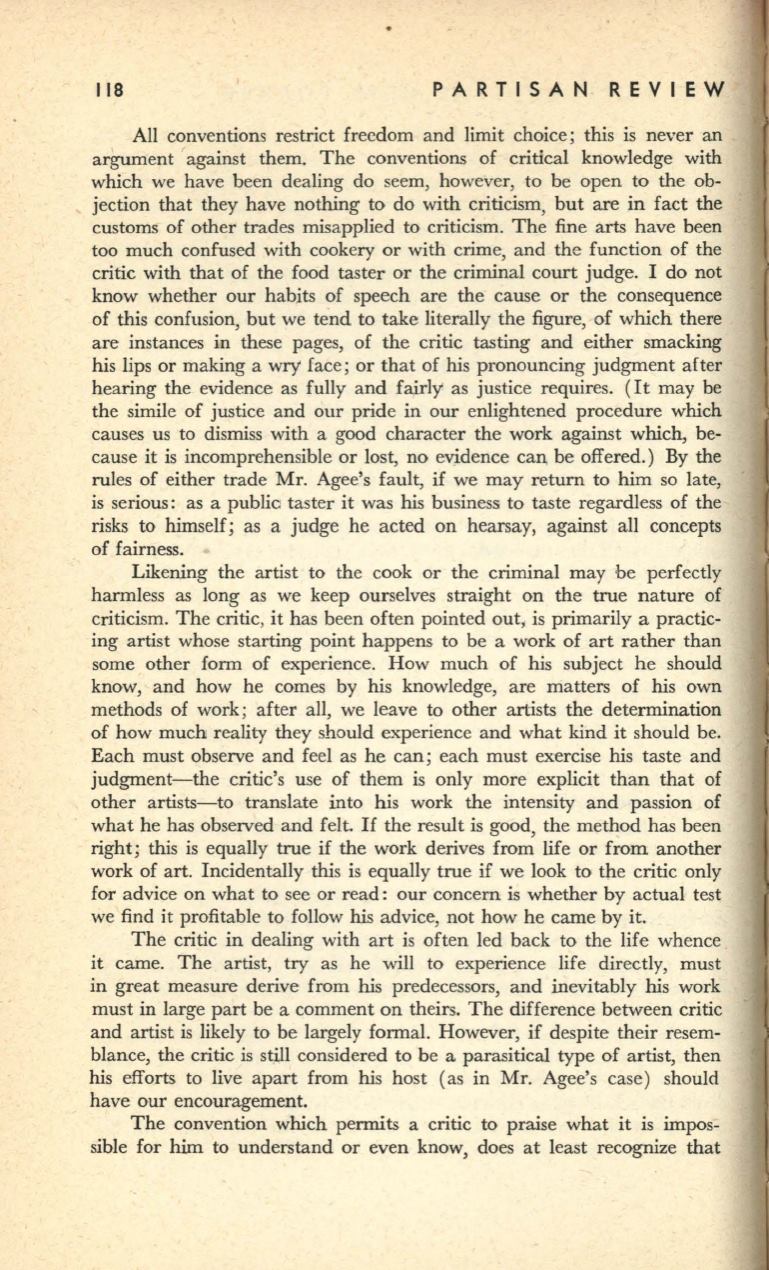
118
PARTISAN REVIEW
All conventions restrict freedom and limit choice; this is never an
argument 'against them. The conventions of critical knowledge with
which we have been dealing do seem, however, to be open to the ob–
jection that they have nothing to do with criticism, but are in fact the
customs of other trades misapplied to criticism. The fine arts have been
too much confused with cookery or with crime, and the function of the
critic with that of the food taster or the criminal court judge. I do not
know whether our habits of speech are the cause or the consequence
of this confusion, but we tend to take literally the figure, of which there
are instances in these pages, of the critic tasting and either smacking
his lips or making a wry face; or that of his pronouncing judgment after
hearing the evidence as fully and fajrly' as justice requires. (It may be
the simile of justice and our pride in our enlightened procedure which
causes us to dismiss with a good character the work against which, be–
cause it is incomprehensible or lost, no evj.dence can, be offered.) By the
rules of either trade Mr. Agee's fault, if we may return to him so late,
is serious: as a public taster it was his business to taste regardless of the
risks to himself; as a judge he acted on hearsay, against all concepts
of fairness.
Likening the artist to the cook or the criminal may be perfectly
harmless as long as we keep ourselves straight on the true nature of
criticism. The critic, it has been often pointed out; is primarily a practic–
ing artist whose starting point happens to be a work of art rather than
some other form of experience. How much of his subject he should
know, and how he comes by his knowledge, are matters of his own
methods of work; after all, we leave to other artists the determination
of how much reality they should experience and what kind it should be.
Each must observe and feel as he can; each must exercise his taste and
judgment-the critic's use of them is only more explicit than that of
other artists-to translate into his work the intensity and passion of
what he has observed and felt.
If
the result is good, the method has been
right; this is equally true if the work derives from life or from another
work of art. Incidentally this is equally true if we look to the critic only
for advice on what to see or read: our concern is whether by actual test
we find it profitable to follow his advice, not how he came by it.
The critic in dealing with art is often led back to the life whence
it came. The artist, try as he will to experience life directly, must
in great measure derive from his predecessors, and inevitably his work
must in large part be a comment on theirs. The difference between critic
and artist is likely to be largely formal. However, if despite their resem–
blance, the critic is st.iii considered to be a parasitical type of artist, then
his efforts to live apart from his host (as in Mr. Agee's case) should
have our encouragement.
The convention which permits a critic to praise what it is impos–
sible for him to understand or even know, does at least recognize that


